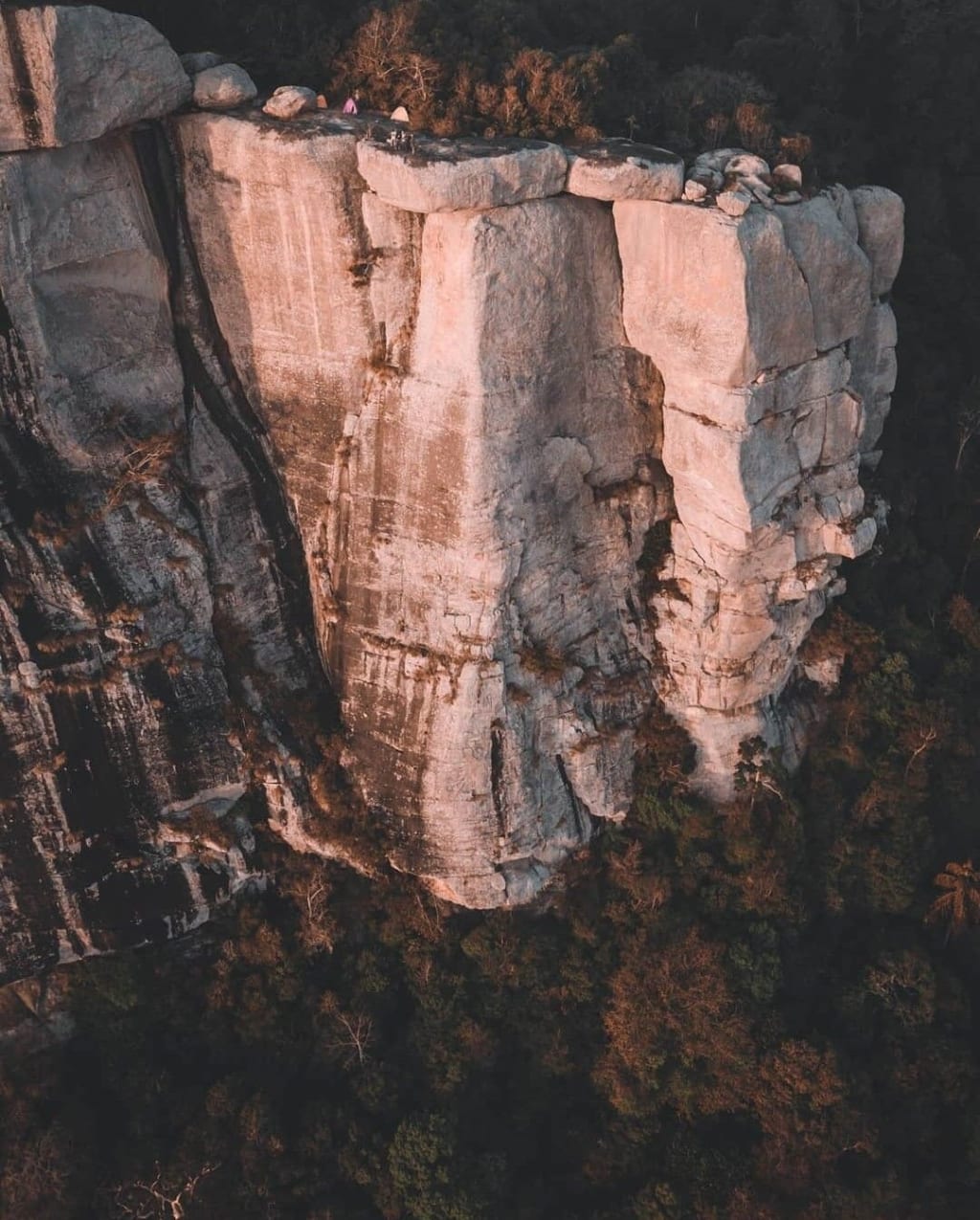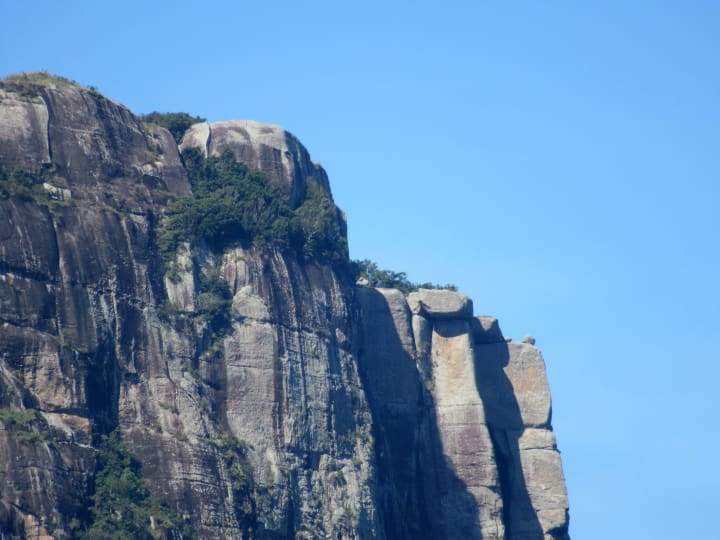
The mountain Dolukanda is located in the Kurunegala District, about 20 kilometers from the city of Kurunegala, near the Hiripitiya hamlet. It rises around 600 meters vertically from the flat plains. Its dimensions are around 2 kilometers long by 0.5 kilometers wide, with a forest reserve on top.
Folklore holds that the Rama-Rawana Legendary Battle served as the starting point for Dolukanda. Lord Rama and his brother Lakshman were both wounded by powerful arrows and knocked out during the battle between Ravana and Lord Rama. In order to preserve their lives, Lord Hanuman was charged with bringing them life-saving herbs from the Himalayas. Because he was unable to recognize the essential plants, he had to transplant a portion of the hill in Sri Lanka that he had previously brought back from India. It is stated that some of the hill's fragments fell on five Sri Lankan places when he was moving it; these areas are believed to be the cities of Dolukanda in the south, Rumasala in the north, Thalladi in Mannar, Ritigala in the east, and Kachchativu in the west. On the other hand, the top of Dolukanda is known as a herbal paradise since a variety of plant species with therapeutic potential may be found there.
Arankele Monastery, which is renowned and situated at the mountain's foot and is regarded as one of Sri Lanka's top forest hermitages, is another reason for the mountain's prominence. Arahants are reported to have lived in a hermitage, and it has been confirmed that renowned Buddhist monk Arahat Maliyadeva Thera was housed there. Dolukanda is also becoming more important historically as a result of the finding of ruins on its peak that are thought to have been there during the time of King Walagamba.

Dolukanda, a location of historical and archaeological significance, is thought to be the location of Lord Weeramunda. Dolukanda, which is a reserve, is under the control of the Forest Department. You must ascent Dolukanda with a unique permit issued by the Forest Department. Additionally, it is crucial to let the Thero know about the Dolukanda Temple since it is where the Dolukanda Climb should begin. A guide to climbing Dolukanda may also be found.
You will pass a lot of gum on your journey up Dolukanda. Large grassy vegetation and enormous russet trees are also seen. These include the uncommon plants known as Gardi Raja. The herb's growth on another plant is significant. Nevertheless, there is evidence of building along the route in the form of black stone remains. Thieves can be seen stealing and destroying several things.
There are gushing springs on the route that overflow the rocky outcrop's roots. Even drinking is OK from the water. You may obtain water from this spring if you go up and sprint out. This is due to the fact that Dolukanda's summit lacks access to drinking water.
At the peak of Dolukanda, there is a location called Maligathenna, which is an excellent location to take in the surrounding area's splendor. The back portion of the palace at the peak of Dolukanda is thought to be Maligathenna. King Walagamba utilized Maligathenna to travel to the Dolukanda temple for worship, according to another account.

You can glimpse the splendor of the North Western Province once you have ascended to the peak of Dolukanda. Kurunegala and Wariyapola are seen from one side, and Wellawa, Deduru Oya, and Yakdessagala Mountain are visible on the opposite side. On a clear day, one can see the coastline all the way to Chilaw.
At the peak of Dolukanda, there are a number of bodies of water. The ponds are deeper, feature black water, and are said to be therapeutic ponds by the locals. These ponds, which are surrounded by towering trees, are said to offer therapeutic qualities.
History of Dolukanda
There is ample proof that King Buddhadasa's medical garden was located in Dolukanda. According to history, he was a remarkable monarch who astounded the world with his Hela medicine. King Buddhadasa allegedly treated both people and animals with kindness.
The history of Dolukanda Mountain is covered in another story. Rama's physicians, according to the Ramayana, urge Hanuman to visit the Himalayan wilderness and bring a healing herb for Rama's wound. Hanuma travels to the Himalayas but is unable to locate the plant; according to legend, the portion where he is said to have the herb came up an entire mountain. The mountain is claimed to have fallen from the sky, and parts of the road are reported to have fallen into Lankapura, Sri Lanka. That is, the regions of the mountain that were thought to contain the plants were Ritigala, Dolukanda, and Rumassala. Today, this tale is being made into a product. Numerous excursions draw attention to these tales in various Sri Lankan locations. However, recent data points to some skepticism regarding this account. Kindly consider this from a logical standpoint.
Due to their biodiversity, many locations in Sri Lanka have been designated as World Heritage Sites. Sri Lanka is home to a large number of indigenous animals, plants, and other organisms. Additionally, it has been shown that Lankapura, Sri Lanka, had herbal gardens managed by famous sages and Vedic instructors long before the aforementioned tale was published. Ritigala is a prime illustration of this. We humbly request that you carefully consider these facts.

Directions to Dolukanda
The Kurunegala District of the North Western Province is home to Dolukanda Mountain. Two paths lead to Dolukanda. One option is to travel from the Muththettugala Junction on the Dambulla Road to the Wellawa Ganewatta Road and then continue on to the Dolukanda Temple. The Dolukanda ascent can then be started from the temple.
The other route is taking the Kurunegala-Dambulla road to Ibbagamuwa and then the Madagalla road, exiting at the Godagala intersection. Then, you may travel across a lovely paddy field from the village of Doluwa to Dolukanda.

On the summit of Dolukanda, there are a number of interesting spots to visit.
Ambalangala
The region around Ambalangala, a rather flat rock, may be seen from a great distance. The Hiripitiya region, Hadurukkanda, Yakdessagala, Kurunegala, and Athugala can all be seen in the distance from this point.
Kalugala
The Daduru Oya reservoir and the Yakdessagala mountain range may be seen from Kalugala, a rocky outcrop.
RakshaMuna
In the region of Raksha Muna, a rock formation is thought to resemble the Devil's face.
HulangKapolla & a Cave
Up to 5–6 people can stay in the cave at Hulang Kapolla, which is a wonderful location to unwind. This would be useful on a camping trip. Although it is a little dangerous, entering the cave is safe to do. This cave was used for meditation by both monks and laypeople, and one side of the cave featured a 500-meter steep drop.

Weheragala
Ritigala, Arankele, Kibulwana reservoir, Dolukanda lake, Ambokka, and Mathale districts, as well as the surrounding areas, are visible from Weheragala's 180-degree panoramic viewpoint.
Forest of Herbs
There may be a variety of medicinal plants in the region.
Maligathenna
The remnants of a former palace may be discovered at Maligathenna. Maligathenna Castle is a historically significant building, according to the locals. The region was littered with moss-covered standing and fallen pillars, as well as some rock walls.
Ponds
Other ponds with names like "Kaludiya Pokuna" and "Wetakei Pokuna" are only a handful of examples that may be found.
Google Map:
About the Creator
Zeloan
I'm a Traveller, Blogger, and Content Creator. Visit Sri Lanka, and you can see the most beautiful places in the world and the remarkable hospitality here






Comments
There are no comments for this story
Be the first to respond and start the conversation.